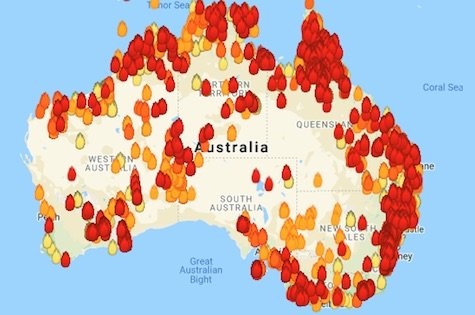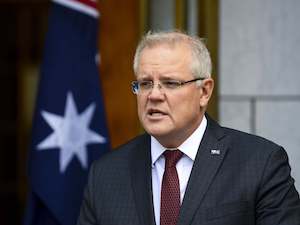SESSION 2
Australia is on fire, literally—and so are its climate politics
NOTE: hover over words in blue for additional information
More than 100 bushfires are raging in Australia: blazes across New South Wales and Queensland have scorched almost 7 million acres, and Australia experienced its hottest day on record Wednesday, when the average temperature across the country hit 105 degrees. The nation's woes are unfolding as Australia faces criticism for what have been described as its inadequate climate policies.
Seasonal bushfires occur naturally in Australia, but hotter and drier conditions due to climate change have increased the frequency of fires and their severity, said Andy Pitman, a climate modeler at the University of New South Wales in Sydney. "There is an uncontroversial link whereby higher carbon dioxide levels in the atmosphere from climate change increase bushfire risk," Pitman said. "All other things being equal, a fire that occurs now will be worse than a fire that occurred 20 to 30 years ago."
Bushfires release carbon dioxide into the atmosphere. So far Australia has released half its annual CO2 emissions.
Trees play an integral role in the planet's carbon cycle by absorbing carbon dioxide as they grow. But research has shown that when vegetation dries out—as during hot and dry summer months—the increased amount of carbon dioxide acts as extra fuel for wildfires. Human activities, such as burning fossil fuels, release greenhouse gases that trap heat and raise surface temperatures, leading to an increase in the frequency of extreme heat events. Those heat waves, combined with dry conditions, are dangerous ingredients for bushfires.
Bushfires are also problematic because they release carbon dioxide into the atmosphere. Australia's fires are estimated to have emitted 250 million tons of carbon dioxide already—nearly half of the nation's total yearly average emissions, according to NASA data.
Those events have renewed focus on Australia's Prime Minister, Scott Morrison, who has refused to answer questions about climate change and their link to the fires. This stance seems symptomatic of Australia's complex history of climate change policy. Australia is the world's largest exporter of coal and its third-largest exporter of fossil fuels, after Russia and Saudi Arabia. Richie Merzian, who worked as a climate negotiator for the government for almost a decade, said those economic ties have shaped the country's climate policies for decades—and invite international criticism. "You can't be the largest exporter of coal, which is the largest source of greenhouse gas emissions when consumed, and not take any responsibility for that," Merzian said.
In 2012, Australia's Labor Government introduced a carbon tax that helped the country reduce greenhouse gas emissions by about 1.4 percent by the end of its second year. But the policy was unpopular, and in 2014, the newly elected government repealed the tax.
As one of the countries that ratified the 2015 Paris Agreement, a global pact aimed at reducing greenhouse gas emissions to fight climate change, Australia will join 187 other countries in pledging to meet its reduction goals next year. Australia has much at stake, with fragile ecosystems, such as the Great Barrier Reef, under severe threat from warming oceans and the country's bushfires. Still, it's difficult to be optimistic about the country's direction.
The Great Barrier Reef will be severely affected by excessive CO2 emissions.
"The Great Barrier Reef is a multibillion-dollar asset to Australia, and it's being sacrificed at the altar of carbon dioxide emissions," Pitman said. "It's really important to understand that decisions that need to be made on carbon emission are politically painful, and there is no one more skilled at avoiding difficult political decisions than politicians."

Australia fires.
Image from time.com.
The summer Australia burned 2019-2020
Youtube.com

Carbon cycle.
Image from klimatetochskogen.nu.

Scott Morrison, Australia's Prime Minister.
Image from independent.co.uk.

The Great Barrier Reef.
Image from theguardian.com.
STRUCTURE
Introduction to the course
- To be done in class.
Civilisation landmark
Reading
- Australia is on fire
Comprehension
- Choose the correct answer
- Did you understand these details?
- Vocabulary
- Australian humour
Language tools
- Numbers and dates
- Verbs
- Fill in the gaps
COURSEBOOK
- Your English teacher will give you a book on the first session.
If you wish to have a digital copy you can download it here and also from Madoc.
DIFFICULTY
- Exercises are marked by level of difficulty. Sometimes you will be able to choose between several options, but you are expected to push yourself to your limit. We have three types:
- [level = EASY]
- [level = TRICKY]
- [level = HARD]
TESTS
CLASS TEST #1 (25%)
- Reading comprehension
- Language tools
- Glossaries
- Cultural landmarks 1-2
CLASS TEST #2 (25%)
- Listening comprehension
- Language tools
- Glossaries
- Cultural landmarks 3-4
CLASS TEST #3 (50%)
- Writing
- Language tools
- Glossaries
- Cultural landmarks 1-6
ONLINE ACTIVITIES
COMPULSORY
The civilisation part (called Landmarks) must be prepared on Madoc. Landmarks are part of the online material you will have to work on this semester.
OPTIONAL
Use the following link or visit the Online Training Page on Madoc for useful grammar revisions, methodology advice and quizzes about science videos.